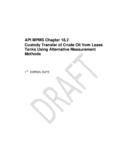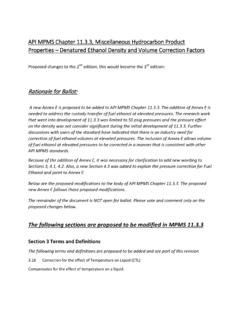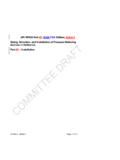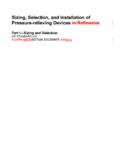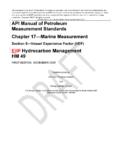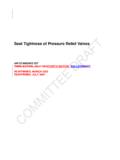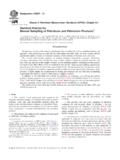Transcription of Manual of Petroleum Measurement Standards …
1 This document is not an API Standard; it is under consideration within an API technical committee but has not received all approvals required to become an API Standard. It shall not be reproduced or circulated or quoted, in whole or in part, outside of API committee activities except with the approval of the Chairman of the committee having jurisdiction and staff of the API Standards Dept. Copyright API. All rights reserved. Manual of Petroleum Measurement Standards Chapter Temperature Determination Liquid-in-Glass Thermometers Page i This document is not an API Standard; it is under consideration within an API technical committee but has not received all approvals required to become an API Standard. It shall not be reproduced or circulated or quoted, in whole or in part, outside of API committee activities except with the approval of the Chairman of the committee having jurisdiction and staff of the API Standards Dept.
2 Copyright API. All rights reserved..1. 1 SCOPE .. 1. 2 NORMATIVE REFERENCES .. 1. 3 TERMS AND DEFINITIONS .. 3. degree .. 3. degree Celsius ( C).. 3. degree centigrade .. 3. degree Fahrenheit ( F).. 3. discrimination .. 3. 3. liquid-in-glass thermometer (LIGT) .. 4. low-hazard liquid .. 4. mercury-in-glass thermometer (MIGT) .. 4. partial immersion thermometer .. 4. total immersion thermometer .. 4. 4 GENERAL PRECAUTIONS .. 4. 4. Mercury 5. 5 UNITS OF MEASURE .. 5. 6 EQUIPMENT AND DESIGN 5. Liquid-in-Glass Thermometers .. 5. General Information .. 5. Liquid-in-Glass Thermometer Assemblies .. 8. Cup-Case Assembly .. 8. Armored Case Assembly .. 9. Angle-Stem 10. 11. Test Thermowells .. 11. Sensor Thermowells .. 11. Selection of Thermowell.
3 11. Pressure Rating .. 11. Installation .. 12. Material .. 12. Thermal Conductivity .. 12. 7 PROCEDURES FOR TEMPERATURE 12. Static Temperature Determination Using Liquid-in-Glass Thermometers 12. General Information .. 12. Procedures for Static Temperature Determination in Non or Low Pressure Tanks and Cargo Carriers .. 16. Procedures for Static Temperature Determination in Pressure Storage Tanks and Cargo Carriers .. 20. Dynamic Temperature Determination Using Liquid-in-Glass Thermometers22. General Information .. 22. Temperature Discrimination .. 22. Dynamic Temperature Determination .. 23. Page ii This document is not an API Standard; it is under consideration within an API technical committee but has not received all approvals required to become an API Standard.
4 It shall not be reproduced or circulated or quoted, in whole or in part, outside of API committee activities except with the approval of the Chairman of the committee having jurisdiction and staff of the API Standards Dept. Copyright API. All rights reserved. 8 INSPECTION, VERIFICATION, AND CALIBRATION REQUIREMENTS 23. 23. General .. 23. New and Recalibrated Thermometers .. 23. Cleaning .. 23. Verification .. 24. Tolerances .. 24. Single-point Verification .. 24. Multipoint Verification .. 24. Prior-to-use Verification .. 24. Periodic Verification .. 25. Ice-point Bath Preparation .. 25. Calibration .. 25. General .. 25. Mercury-in-Glass Tank Thermometers .. 26. Low-hazard Liquid-in-Glass Tank Thermometers .. 26. Reference Thermometers.
5 26. Calibration Documentation or Certificates .. 26. Calibration Correction Factors .. 27. ANNEXES. Annex A (Informative) Mercury-in-Glass Thermometer Alternative Testing Phase I. - Tank Measurement .. 28. Annex B (Normative) Emergent-Stem Correction for Liquid-in-Glass Thermometers .. 30. Annex C (Informative) Test Procedure for Determining Immersion Times of Liquid-in- Glass Thermometers and their Assemblies .. 37. Annex D Local Direct-Reading Thermometers .. 40. FIGURES. Figure 1 Types of Glass Thermometers and Their Use ..6. Figure 2 Typical Cup-Case Assembly .9. Figure 3 Typical Armored-Stem Assembly 10. Figure 4 Typical Angle-Stem Thermometer ..11. Figure B-1 Thermometers Immersed in Bath ..30. Figure B-2 Total Immersion Thermometer Partially Immersed in a Thermowell.
6 31. Figure B-3 Clip to Suspend Ambient Temperature Thermometer ..32. Figure B-4 Measuring Temperature of Emergent Liquid Column ..32. Figure B-5 Measuring Between Immersion Ring and Start of Temperature Scale (34 mm) ..34. Figure B-6 Determining How Many Degrees on the Thermometer Scale Corresponds to 34 mm (7 degrees) .34. Page iii This document is not an API Standard; it is under consideration within an API technical committee but has not received all approvals required to become an API Standard. It shall not be reproduced or circulated or quoted, in whole or in part, outside of API committee activities except with the approval of the Chairman of the committee having jurisdiction and staff of the API Standards Dept. Copyright API.
7 All rights reserved. TABLES. Table 1 Maximum Deviation Limits: Operating Thermometer Versus Reference Thermometer ..6. Table 2 Tank Thermometers ..7. Table 3 Dynamic Temperature Thermometers ..8. Table 4 Minimum Number of Temperature Measurements for Various Depths of Hydrocarbon Liquid in Storage, Lease, Ship and Barge Tanks .13. Table 5 Recommended Immersion Times for Woodback Cup-Case Assemblies .15. Table 6 Thermometer Assemblies and Temperature Levels for Tanks and Cargo Carriers 19. Table 7 Temperature Measurements for Horizontal Cylindrical Tanks 20. Table C-1 Suggested Bath Temperature ..38. Table C-2 Time Intervals for Reading Thermometers ..38. Table D-1 Tank Appurtenances for Temperature Measurement ..40. Page iv Manual of Petroleum Measurement Standards API MPMS Chapter Liquid-in-Glass Thermometers INTRODUCTION.
8 This section describes how to correctly use various types of liquid-in-glass thermometers to accurately determine the temperatures of hydrocarbon liquids under both static and dynamic conditions. However for specifics on using liquid-in-glass thermometers for dynamic Measurement see API MPMS Ch. temperatures are used to convert hydrocarbon liquid volumes to base conditions. Other methods, equipment, and procedures for temperature determination are described in the other sub-sections of API MPMS Ch. 7. The method and equipment selection for temperature determination are left to the discretion of the parties involved. 1 SCOPE. This chapter describes the methods, equipment, and procedures for manually determining the temperature of liquid Petroleum and Petroleum products under both static and dynamic conditions with liquid-in-glass thermometers.
9 This chapter discusses temperature Measurement requirements in general for custody transfer, inventory control, and marine measurements. The actual method and equipment selected for temperature determination are left to the agreement of the parties involved. The Manual method covers: Non-pressurized tanks and non-pressurized marine vessels Gas-blanketed tanks and gas-blanketed marine vessels It does not cover hydrocarbons under pressures in excess of 21 kPa (3 psi gauge) or cryogenic temperature Measurement , unless equipped with a thermowell.. The requirements of this chapter are based on practices for crude oils and Petroleum products covered by API MPMS Ch. (ASTM D1250). Requirements in this chapter may be used for other fluids and other applications.
10 However, other applications may require different performance and installation specifications. 2 NORMATIVE REFERENCES. API. Manual of Petroleum Measurement Standards Chapter 1, Vocabulary Chapter 2, (all sections) Calibration of Upright Cylindrical Tanks Chapter 3, (all sections) Tank Gauging Page 1. Chapter , Standard Practice for Manual Sampling of Petroleum and Petroleum Products Chapter , Physical Properties Data, Temperature and Pressure Volume Correction Factors for Generalized Crude Oils, Refined Products, and Lubricating Oils Chapter , Calculation of Static Petroleum Quantities Upright Cylindrical Tanks and Marine Vessels Chapter , Calculation of Petroleum Quantities Using Dynamic Methods and Volumetric Correction Factors Chapter 15, Guidelines for Use of the International System of Units (SI)
